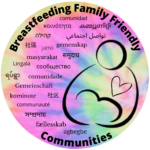STEP 7: The businesses and organizations in the community welcome chest/breastfeeding families.
Step 10: Education systems, including childcare, K-12, colleges and universities, are encouraged to include chest/breastfeeding-friendly curricula at all levels.
Ten Steps to a Breastfeeding Family Friendly Community
We are pleased to share digital folders set up by Breastfeeding Family Friendly Communities of Durham (NC) to help you with your work to become a Breastfeeding Friendly Child Care Provider. Each folder contains a number of “Google Docs” and “PDFs.” Please contact us with any feedback or questions.
Where to start:
- Briefly review the Self Assessment (update with improvement)
- Briefly review the Sample Action Plan
- Briefly review the Action Plan (fill this out as you read through the sections below and return to it at the end)
Community: Information from Durham, NC, a pilot city, is used to give specific examples. Local communities should substitute local information.
- Review and familiarize yourself with everything in the folder, which includes:
- a list of the Local Community breastfeeding resources (see “COMMUNITY CONNECTIONS STANDARD: Educational materials” for ideas about the community resources that Durham NC collected), and
- information and culturally-appropriate educational materials.
- Print the items to use within your childcare program.
- Update your action plan steps 3, 6, & 9.
- Print the items in this folder, posting them in the public spaces throughout your program to let families know that the program is breastfeeding-friendly.
- Additional resources can be found on the NC DHHS Breastfeeding Friendly Child Care page under “Resources.”
- Note: If you use other materials, please remember that materials you display cannot promote or advertise formula, that is, they cannot be created by a formula company or contain a formula company logo.
- Update your action plan steps 6 & 10.
Professional Development: Local community should substitute local information.
- Take a few minutes to gather all the documentation of your center’s breastfeeding friendly professional development in one location.
- Online Training Options:The recommended online option is CGBI’s Breastfeeding University.
- Completion of the free four online modules will total two hours of cumulative training.
- This might be a great time to have your staff do some online training.
- Update your action plan steps 2 & 10.
- Work on interactive and developmentally appropriate learning opportunities that normalize breastfeeding for children in your program.
- In the digital folder, there are a number of documents that list books and materials that normalize breastfeeding (i.e., games, storytelling, books, toys).
- Complete the CURRICULUM STANDARD with activities and materials that you and your staff put together.
- Update your action plan step 4.
- Review your breastfeeding policy, or write one.
- Review your Breastfeeding Friendly Employer Policy, or write one.
- Review or write your Infant Feeding Plan.
- Review the Milk Storage Guidelines.
- Update your action plan steps 1, 3, 5, 6, 7, & 8
You are almost done!
- Update your Self Assessment
- Update your Action Plan
We thank you for your interest in supporting breastfeeding families. We are happy to assist in any way you may find helpful. Please do not hesitate to contact us.
For help or support email: Breastfeeding Family Friendly Communities
Resources
- New South Wales (NSW, Australia), Southern NSW Local Health District: Encouraging and Supporting Breastfeeding in Childcare Resource Kit
- Wisconsin Breastfeeding Coalition Breastfeeding Friendly Child Care
Coronavirus Information
- NC Coronavirus Information for Child Care
- CDC Guidance links for Child Care Programs
- ZERO TO THREE
- Considerations for Developmental Needs of Infants and Toddlers in Child Care Programs During the COVID-19 Pandemic
- “Design policies to continue to promote breastfeeding: While restricting the number of people entering child care facilities is important for reducing the risk of virus transmission, policies making exceptions for breastfeeding parents should be put in place and clearly communicated to families.”
